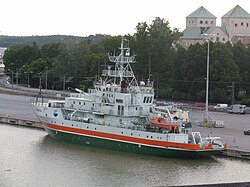Aranda (ship)
|
||||||||||||||||||
|
||||||||||||||||||
|
||||||||||||||||||
|
||||||||||||||||||
|
||||||||||||||||||
|
||||||||||||||||||
The Aranda is a Finnish research ship of Suomen ympäristökeskus (Finnish Environment Institute, SYKE) bereedert it is of VG-Shipping. The ship was designed for use in the Baltic Sea , but can also be used in other sea areas including the polar regions.
history
The ship was built under the hull number 406 at the Laivateollisuus shipyards in Turku and Wärtsilä in Helsinki and was completed in June 1989. The ship was christened on June 15, 1989. Godmother was Raija Voipio, the wife of the then director of the Finnish Marine Institute. The ship replaced the previous building of the same name . The ship was designed by Aker Arctic Technology.
From the end of July 2017, the ship was rebuilt by Rauma Marine Constructions in Rauma and lengthened by seven meters. The additional section was added directly behind the deckhouse , and the stern was rebuilt. The conversion was completed in September 2018 and the ship will remain usable through the conversion until 2030.
Technical specifications
The ship is powered by diesel-electric technology . Propulsion for the two are electric motors of the manufacturer Bakker, each with 1,500 kW power available, via a reduction gear to a pitch propeller effect. The power for the drive motors is generated by two generators from the manufacturer Strömberg, each with an apparent power of 1,570 kVA , which are driven by two diesel engines from the manufacturer Wärtsilä with an output of 1,300 kW (type: Wärtsilä Vasa 8R22MD) or 1,700 kW (type: Wärtsilä Vasa 12V22MD) . There are also three generators from the manufacturer Strömberg, each with an apparent power of 350 kVA, which are driven by diesel engines from the manufacturer Cummins with an output of 280 kW each. In addition, an emergency generator ( Valmet 411) with an output of 52 kW was installed.
The ship is equipped with a bow thruster with 400 kW power and a stern thruster with 150 kW power. The ship is equipped with a dynamic positioning system ( DGPS and DP ).
During the renovation, the machine system will also be overhauled and the engines converted for operation with biodiesel. In addition, the ship should be able to cover short distances with a purely electric drive. Appropriate accumulators are installed for this. As an additional drive, the ship gets a 360 ° rotatable water jet drive . The water jet drive can also be used as an emergency drive.
In addition, the installation of two fuel cells is planned to provide the electricity for the research facilities and the living area on board.
The hull of the ship is reinforced with ice . The ship is classified as ice class 1A Super and can break ice up to half a meter thick.
Furnishing
The ship carries a 6.25 meter long and 2.15 meter wide workboat. The workboat is equipped with a water jet drive and has a maximum speed of 30 knots . The ship is equipped with a hangar equipped and can two helicopters of the type Bell 206B Jet Ranger carry.
There are several laboratories on board. It also has various sonar and echo sounder systems and is equipped for the use of ROVs . The ship is equipped with a moon pool and various winches for the research work.
The working deck is 110 m². At the stern of the ship there are two stern booms that have a lifting capacity of 10 and 1.5 tons respectively. The hydraulically operated crane on the aft deck can lift 3 tons. Two 20-foot containers can be stowed on the boat deck . The ship can stay at sea for up to sixty days, covering around 15,000 nautical miles .
On board there is space for 13 crew members , who are accommodated in single cabins, as well as 27 scientists, for whom a single cabin and 13 double cabins are available.
literature
- New research vessel - new epoch. In: Navigator - The Finnish Maritime Montly , 6/89 (PDF, 1.2 MB)
Web links
- Research Vessel Aranda , Finnish Environment Institute
- Manual (PDF, 1.3 MB)
- Brochure (PDF, 1.7 MB)
Individual evidence
- ^ Aranda , Research vessel, VG-Shipping. Retrieved February 10, 2020.
- ↑ Research vessels Aranda and Muikku , Finnish Environment Institute (SYKE). Retrieved March 22, 2018.
- ↑ a b c d Aranda’s technical information , Finnish Environment Institute (SYKE). Retrieved February 10, 2020.
- ^ Nautilus and old Aranda ships , Finnish Environment Institute (SYKE). Retrieved August 27, 2019.
- ^ Aranda ( memento of March 23, 2018 in the Internet Archive ), Aker Arctic Technology.
- ↑ a b Marine research vessel Aranda will be completely refurbished - modification of this special vessel poses a challenge to Finnish shipbuilding expertise , press release, Finnish Environment Institute (SYKE), August 17, 2017. Accessed March 22, 2018.
- ^ Renovated marine research vessel Aranda embarks immediately on a research cruise. Press release. Finnish Environment Institute, September 7, 2018, accessed May 8, 2020 .
- ↑ a b c Dag Pike: Major refit for 'Aranda' , Maritime Journal, January 5, 2018. Retrieved March 22, 2018.
- ↑ Powering ahead: The big alternatives , The Motorship, February 7, 2017. Accessed March 22, 2018.
- ^ Vessel Data and Contact Information for the Aranda , International Research Vessel Schedules & Information, Oceanic Information Center. Retrieved March 22, 2018.
- ^ Aranda , European Vessel Database, Eurofleets. Retrieved March 22, 2018.
